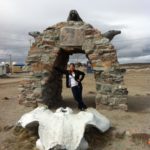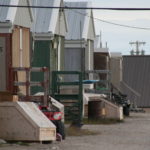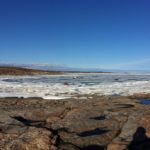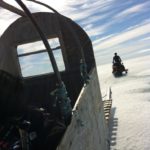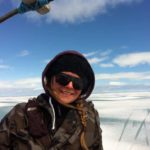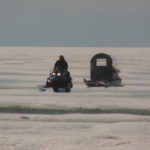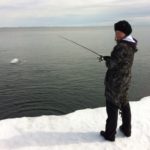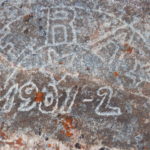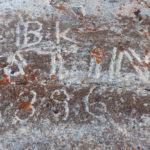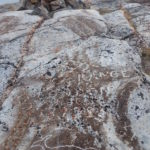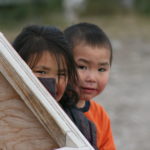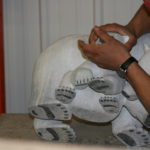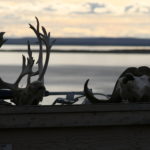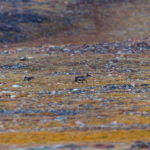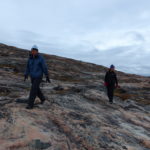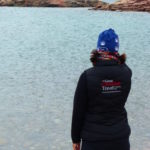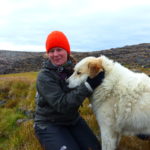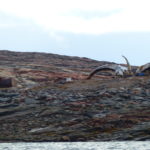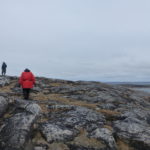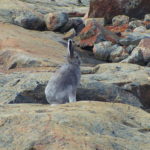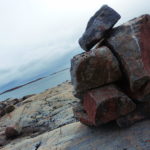Canada’s north is such a vast and wild region and our clients often ask us “Where should I go?”. To be honest, there are different highlights to any of the northern communities and national parks, but one in particular, I have grown to be quite fond of.
I am referring to the community of Naujaat (formerly called Repulse Bay) that lies right on the Arctic Circle in the Kivalliq region of Nunavut. Naujaat, which is the Inuktitut name for “Seagull Nesting Place” from the nearby cliffs that are breeding grounds for seagulls and other birds every year. Trekking out to see these cliffs are just one of the hikes and activities that you can do on our Arctic Circle Expedition.
The expedition begins in Winnipeg, in the heart of the Canadian prairies. If you haven’t been before I highly suggest allowing yourself time for a pre or post stay. This capital city is full of activities and attractions, especially during the summer months.
From Winnipeg we fly up to Naujaat with Calm Air. Calm Air is one of the few airlines offering service to Canada’s northern territories. There are daily flights from Winnipeg to Naujaat but the route of your flight will always depend on the day that you fly. There is the “direct route” that only has 1 stop in Rankin Inlet, NT or there is what we call the “Milk Run’ which stops in several communities on the way up including Churchill, Rankin Inlet, and Coral Harbour. All of the stops may not sound ideal, but this is how I have travelled up to Naujaat each time and I love it. if you are fortunate enough to be flying on a clear day, the view of the changing landscape from the plane is definitely a sight to see.
Once we arrived in Naujaat we were met at the airport by the manager for the Naujat Hotel, in his own personal truck to drive us to our accommodations. Not that it was necessary to drive us, we could see the hotel from the tiny airport and could have easily walked, but he took us on a little drive through the community before circling back towards the hotel. It was nice to get us acquainted a bit with our surroundings so we would have an idea where to explore on our own throughout the trip.
If you didn’t know already, I will let you know now that the accommodations throughout the north are very basic and you do need to prepare yourself for that. But the hotel is clean and comfortable and the restaurant there serves 3 hot, home cooked meals a day. Get a good rest on your first night because touring starts the next morning and will keep you busy for the rest of your time at the Arctic Circle.
I have done this trip in both June and August, both times were great and there was never a shortage of touring, but the types of touring will differ between the months of April and August. One of the highlights for me was the trip out to the floe edge. The best time to include the floe edge as part of your expedition is from early to mid June. This time frame offers the safest conditions to travel across the ice floe to the open water. We did this trip by qamutik, attached to the back of a snow machine. A qamutik is a traditional sled that is designed to travel across the snow and ice. This trip can also be done by dog sled but with the snow machine it took about 2 hours to get to the open water. This may sound quite lengthy but there was never a dull moment, whether it was stopping to scan for polar bears, or taking photos of the seals near their breathing holes (if you could snap any before they would slip back into the water), or crossing the cracks in the sea ice, there was never a lack of excitement.
Once we made it out to the open water, we spent the afternoon drinking tea and listening to stories from our local Inuit guide that spoke about his life growing up in the community and his encounters with polar bears and whales. He would break from time to time to stand on a mound of snow and scan the area for polar bears and to let us try our luck at fishing for Arctic Char. We didn’t catch anything that day but it was fun to pass the time. From time to time we could hear the spray from blow hole of what our guide explained was a bowhead whale in the distance, but the defining moment of the day was right as I reeled in my fishing rod and we spotted a pod of narwhals. This was an amazing moment that we had all been waiting for and although we were all hoping that we would see a narwhal (never mind a pod of them), they are so elusive we never really knew if we actually would spot any. For those who don’t know, narwhal is a species of whale that lives in Arctic waters. Their distinctive feature is the large white tusk (that can grow up to 9 feet long) that resembles that of a unicorn. We watched the whales approach as they swam in small groups, tusks peeking out of the waters, crossed past us and underneath the ice floe about 20 feet from where we stood. We stood in silence the whole time, truly appreciating how fortunate we were to be seeing such a sight. The only thing that could have topped that day would have been to see the other whale species that have been seen in those waters which are orcas or beluga whales. The trip back to the community was filled with excitement again as we reminisced about what we had just experienced.
The next morning, we headed out to the Harbour Islands. There is where we had the opportunity to see some of the history of the area with our own eyes. Back in the 1800’s the area was frequently visited by whaling vessels from Europe. The Harbour Islands are a reminder of the whaling history if the area with inscriptions on the rocks from whalers of that era. We got back early enough that day to do a community tour in the afternoon, with our guide at first before continuing to explore on our own. There are many local artists that come from Naujaat. We were fortunate to have been walking past the home of Paul Maliki who showed us his workshop and some of the carvings he was currently working on. Groups of curious children would follow us and many would come ask us where we were from. They were happy to walk and talk with us and would often disappear then show up somewhere else a little later on. The Co-op is where they sell food and other supplies but you will also find a selection of locally made jewellery and art. The pieces are beautiful and one of a kind. And lastly, don’t forget to stop by the Hamlet Office to get your Arctic Circle Crossing certificate, it a great memento for an unforgettable trip.
During the summer months you have the option to do the land tours by ATV and then hike or even kayak. The sprawling tundra is a sight to see whether it is covered in snow or bare and rugged. Caribou can be spotted in the area, along with polar bear, arctic hare and even wolves. Naujaat is by far one of the most interesting and unique northern communities I have been fortunate enough to visit, maybe that is because it gave me the exciting experience of seeing the pod of narwhals or maybe it is because of its unique location right on the Arctic Circle. Either way, even though it has already been checked off my bucket list, it’s left me wanting to return and explore some more.








